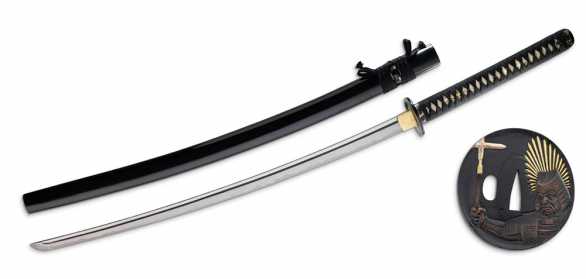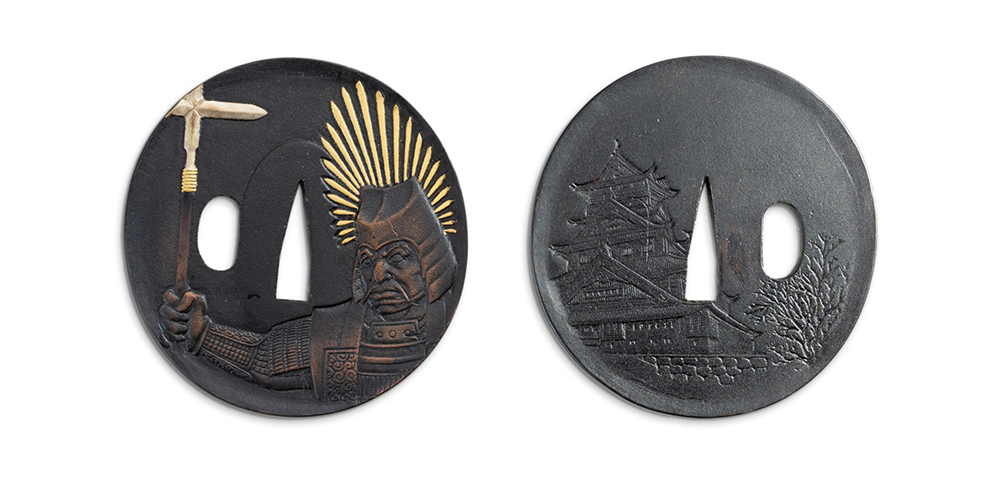Hanwei Toyotomi Hideyoshi Katana
 Be the first one to write a review
Be the first one to write a review FINAL CLOSEOUT SALE
FINAL CLOSEOUT SALE
FREE US SHIPPING
27" Differentially hardened T10 tool steel blade with 12" handle based on the legendary Daimyo, Toyotomi Hideyoshi. MSRP $1,039
Toyotomi Hideyoshi, born Hiyoshimaru in 1536, rose from peasant status to chief minister of the emperor in 1585 in attempt to complete the goal of unification of Japan by his fallen leader Oda Nobunaga. In 1568 when Nobunaga began his siege of central Japan Hideyoshi fought in many of those important battles. His judicious behavior, positive countenance and intelligence helped him rise through the ranks. Though his lowly origins bely the latter of those traits, Hideyoshi was the architect of many reforms of feudalism in Japan as well as becoming a master of the tea ceremony and educated himself in secret. In 1577 Nobunaga charged Hideyoshi with the subjugation of western Japan. After the betrayal of Nobunaga's retainer, Akechi Mitsuhide, and Nobunaga's suicide, Hideyoshi sought immediate revenge on his leader’s traitor and defeated him at the Battle of Yamazaki.
Hideyoshi followed by securing the line of succession by Nobunaga's grandson. After subduing one the powerful vassals supporting Nobunaga's third son, Hideyoshi began fortifying the country by securing all the strongholds and building Osaka castle. Soon after he started the unification process of Japan to complete his mentor's work. After battling Tokugawa Ieyasu which led to a draw, they ended their conflict with an alliance. In 1585 Hideyoshi was appointed kampuku (chancellor to the emperor) and was given the family name of Toyotomi. After subduing the last of the resistance with his new ally, Ieyasu, they went about securing power and stability for Japan by disarming the population, reducing the number of castles and strongholds within the country and freezing the social classes. Hideyoshi abolished road checkpoints to encourage travel and trade. He also conducted large land surveys to develop mineral resources for the formation of coinage to also assist with economic growth.
In 1590, Hideyoshi was the head of daimyo alliance the formed the government of national unification. Soon after Hideyoshi passed on his position of kampuku to his nephew, Toyotomi Hidetsugu. In 1592 Hideyoshi began an invasion of Korea which ended in failure but tried again in 1597 and failed. Hideyoshi died in 1601 at the age of 62 where he spent his latter years burdened by his defeat in Korea. Two years after Toyotomi Hideyoshi's death, Ieyasu took control of the government and founded the Tokugawa shogunate. Ieyasu continued Hideyoshi's policies of unification which led into a time of peace in the Tokugawa era.
Hanwei has created a genuine piece of sword art with the Toyotomi Hideyoshi Katana. The tsuba depicts the image of Hideyoshi embossed with gold detailing and an etching of Osaka castle on the opposite side. The fuchi illustrates the tea ceremony with gold detailing and as well as kashira with its depiction of Osaka castle. The handle is wrapped in black cotton over white same. The 27” forged blade features a hi on both sides to make this a light and quick katana. The deep black lacquered saya completes the piece. The Toyotomi Hideyoshi Katana represents the best of Hanwei craftsmanship and sword art which will satisfy the practitioner and the collector alike.
Functionality and Intended Use
Please note: Please note: the sageo (cord) on the saya (scabbard) may not be wrapped as pictured. Sageo colors may vary.








